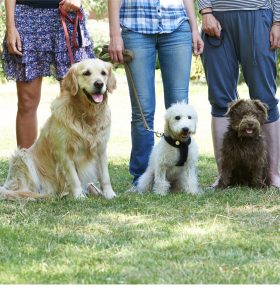Filling classes can be challenging, particularly for smaller businesses. So many stars must align for potential clients: The right class on the right day of the week at the right time and starting on the right date. Larger, established facilities offering a full schedule can stagger multiple classes to meet this challenge, but new and smaller businesses often find classes cancelled due to under-enrollment when the stars don’t sync.
 If you’re having trouble filling classes, an open enrollment platform can help you get more clients by offering a flexible schedule.
If you’re having trouble filling classes, an open enrollment platform can help you get more clients by offering a flexible schedule.
What is open enrollment?
Open enrollment means students can start class any time. If you’re teaching a six week program and receive a call three weeks in, simply sign the client up to start. They’ll take the program sequentially, attending 6 weeks in a row in this order: Week 3, 4, 5, 6, 1, 2. Somebody wants to enroll in week 5? No problem. They’ll attend sessions 5, 6, 1, 2, 3, and then graduate week 4.
Why open enrollment?
To stop losing clients and revenue. When your schedule doesn’t meet a dog owner’s needs, she’s likely to move on to another trainer, even if you were her first choice. You miss out not only on this client’s attendance in her first class, but also future revenue from repeat business. Open enrollment also saves you from a loss of revenue due to cancelled or postponed classes while you wait for a minimum number of students to enroll.
To make scheduling easier. By removing concerns over start dates from the scheduling equation you make your job easier and remove a potential obstacle for interested clients.
To get your classes filled. You’re much more likely to fill your classes if you hold them. Starting with a few students and adding as you go helps you arrive at full classes more quickly because your classes are always available to interested dog lovers.
To take full advantage of puppies’ socialization window. Open enrollment is particularly useful for puppy classes. Puppies never have to wait for a new class to start, and beginning right away means more socialization when it counts most. And the influx of new puppies throughout the program provides additional socialization opportunities.
Getting started with open enrollment.
Choose your first start date and market your classes. List the day and time your classes are held, but not specific dates. Make it clear that new students are welcome any time.
If only a few people have enrolled when the day of your first class arrives, go ahead and hold class. As the weeks pass, add new students as they register. Use a simple class roster system (or whatever software you already use) to keep track of when each student will graduate. This way, as your class fills, you know when your next vacancies for new students will be. Once you regularly have to ask people to wait more than a week to start class, you know it’s time to add a new class.
If you find you’re still having difficulty building your first class—not at all uncommon for new programs—try a few tricks to fill seats. (I recommend this in particular for puppy classes, where it’s necessary to have multiple pups for socialization.) Invite rescue groups who use a foster system to give free passes to any foster parents currently caring for puppies. Offer spaces to breeders looking for socialization and training opportunities for their charges. You can invite shelter volunteers to bring puppies as well, but use caution, as puppies can be exposed to kennel cough, parvo, and other serious communicable diseases in shelter environments.
Open enrollment curriculum
Open enrollment classes demand a new, exciting approach to curriculum development. Standard education models require lessons to build on each other over time. Session one prepares students for what they will learn in session two, which in turn prepares them for what they’ll learn in session three, and so on. But in an open enrollment class, you may have five-week veterans sitting next to students attending their first time. Without a new approach to teaching, it’s easy for classes to devolve into a series of mini private lessons in which the trainer must hurry from student to student trying to meet a room full of disparate needs. This approach lacks the clarity and cohesiveness that make students want to come back next week and for the next class.
In our curriculum design and in our curriculum development workshops, we use and teach an approach called self-contained lesson planning. There are three key ingredients:
1. Lessons build on each other within a class session, rather than building from week to week.
2. Lessons are designed to be approached from multiple skill levels so everyone in class can participate equally and productively, regardless of how long they’ve been there.
3. Lessons are built around real-life problem solving that teaches students the skills they’ll need outside the classroom.
As an example, think about teaching stay. Typically stay is taught over several weeks, breaking the concept into distance stays, duration stays, distraction stays, and finally teaching clients how to combine them all.
In an open enrollment setting, we don’t afford ourselves the luxury of teaching this way. Instead, we might teach a simple duration or bungee stay and then jump right into problem solving distraction in the same session. What? Isn’t that too much? On the contrary, the more your training class mirrors and teaches how to deal with real life, the better. And real life is full of distractions.
Our stay lesson might look like this: Once we’ve introduced the basics (which will be new to some, a review for others), we provide a challenge. Let’s say we bring a distraction into the room. It could be a new dog, or someone bouncing a tennis ball, or any other number of things. We place the distraction on one side of the room. Now students must practice their stays. Their job is to decide where in the room to position themselves and their dog in relation to the distraction, and then how difficult a stay to ask for. In making what seems like simple decisions, students are learning to practice situational awareness and criteria setting, two critical skill sets for successfully living with dogs outside the classroom.
Because the object of the lesson is to make good criteria decisions, rather than to achieve a stay of a certain distance or duration, each student, no matter her or her dog’s experience level, can achieve success. Success for one student-and-dog team might be a two-second stay across the room from the distraction while another team celebrates two minutes up close. For both teams, the success was really the owner’s ability to assess the situation and work at her dog’s level—just what she’ll need to do when she leaves class.
The trainer’s job? To reinforce good decisions and unprompted adjustments (such as a student choosing to move farther from the bouncing tennis ball after a failed trial) and to prompt adjustments as needed for new students just encountering this decision making process.
Though open enrollment requires trainers to learn new teaching techniques and approaches to curriculum, the rewards are well worth the effort. Consistently filling classes year round is an ongoing challenge for all but the most well-established training studios. Open enrollment classes help to address this business need while providing a rich experience students can apply outside the classroom, where it really counts.
Want some help with your curriculum? Check out these resources:
Learn how to make yours The Best Classes in Town with this dogbiz University course.
Jump start your open enrollment classes with a dogbiz curriculum package:
Want to read more?


